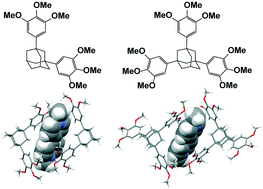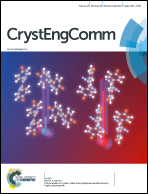Preparation and crystal structures of charge-transfer complexes of acyclic host molecules bearing pyrogallol derivatives with paraquat†
Abstract
Adamantane-based molecules possessing two or three pyrogallol derivatives as acyclic host molecules were developed to examine their potential to form complexes with pyridinium-based dicationic compounds, which are well known as guest molecules of macrocycles, including calixarenes, pillararenes, and others. The complexation of paraquat (3) with 1,3-bis(3,4,5-trimethoxyphenyl)adamantane (1) in acetone afforded reddish brown cocrystals with a 2 : 1 host : guest complexation stoichiometry. X-ray crystallographic analyses revealed that one guest molecule is included in the space between two adamantane-based molecules possessing bent and rigid frameworks, where donor–acceptor and CH⋯π interactions between 32+ and the trimethoxyphenyl groups in 1 were observed. Further, the mixing of 3 and 1,3,5-tris(3,4,5-trimethoxyphenyl)adamantane (2) gave cocrystals with a 1 : 2 stoichiometry, where one dicationic guest is surrounded by four electron-rich trimethoxyphenyl groups of two molecules of 2, resulting in the formation of charge-transfer complexes through similar non-covalent interactions.



 Please wait while we load your content...
Please wait while we load your content...